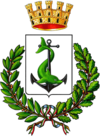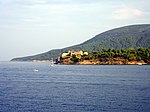Capoliveri
| Capoliveri | ||
|---|---|---|

|
|
|
| Country | Italy | |
| region | Tuscany | |
| province | Livorno (LI) | |
| Coordinates | 42 ° 45 ' N , 10 ° 23' E | |
| height | 167 m slm | |
| surface | 39 km² | |
| Residents | 4,103 (Dec. 31, 2019) | |
| Population density | 105 inhabitants / km² | |
| Post Code | 57031 | |
| prefix | 0565 | |
| ISTAT number | 049004 | |
| Popular name | Capoliveresi | |
| Website | Capoliveri | |
 Capoliveri |
||
Capoliveri is the southeast of the seven Italian municipalities on the Tuscan island of Elba and has 4103 inhabitants (as of December 31, 2019).
geography
The historical place is located at an altitude of 167 m on a hill near the Monte Calamita ( 413 m slm ). The municipality, which also includes the scattered settlements of Lacona, Madonna delle Grazie, Morcone, Pareti and Innamorata, has an area of 39 square kilometers. The neighboring municipalities are Campo nell'Elba , Portoferraio and Porto Azzurro .
history
The area around Capoliveri was already populated in Etruscan times. This is evidenced by finds from coins and graves that are now kept in the Archaeological Museum in Naples . In Roman times the names Caput Liberum , Capitis Ilvae , Caput Liseri or Caput Liveri have been handed down. How that was meant is unclear. A free head would be possible as well as a connection to the fertility god Liber , who is connected to the wine god Bacchus . Since Pliny already described viticulture in the region, historians consider the latter explanation to be conclusive.
After the fall of the Roman Empire, the area around Capoliveri became a place of refuge for refugees from the Tuscan mainland during the Germanic migrations. Incidentally, it shares the history of the island of Elba.
During the Napoleonic campaigns of conquest in 1799, the population of Capoliveri offered strong resistance and destroyed a troop who had fled Longone; In return, a troop advancing from Portoferraio devastated the city. Against this background, it can be explained that in 1814, when the other communities on the island kindly received the exiled Napoleon Bonaparte as Emperor of Elba , Capoliveri was the only place to react with hostility and the residents refused to pay taxes. The two clergymen who led the opposition to Napoleon were ultimately arrested.
At the time of the Italian unification movement ( Risorgimento ), a doctor named Vincenzo Silvio (born in Capoliveri on May 9, 1805) was known as a tragic local hero. He had himself arrested by the Italian nation-state in Rome for his ideas and accepted that his license was withdrawn in 1851 “because of incompetence”. After 1860 he was rehabilitated and remained a military doctor until his death in 1873. A street in Capoliveri is named after him today.
Today's Capoliveri lives primarily from tourism.
Attractions
- The old town of Capoliveri is built on a hill in the typical style of a medieval borgo (fortified village); narrow streets with Schwibbogen and stairs lead up to the central Piazzetta Matteotti ( ⊙ ). There are small shops and restaurants in the winding stairways.
- The preserved apse of the parish church of San Michele (12th century), which stands on the foundations of a previous building, is built in the Romanesque style of Pisa . According to legend, a pope on his way back from captivity from Avignon to Rome ( Avignon Papacy ), surprised by a storm, went to the small church to read mass there. In the first half of the 16th century, the church, apart from the apse, was destroyed during the invasion of the corsairs under Cheir ed-Din Barbarossa and then only used as a cemetery until Napoleon banned burials in churches.
- The Chiesa di San Gaetano on the Piazza Garibaldi in the town center was reopened on August 7, 2011 after extensive restoration work. Written records about the exact time of origin and its builder have not yet been found. Based on analyzes and research and thanks to a memorial plaque on the inner wall above the entrance door, it is assumed that the little church was built in 1775 as a private chapel by the Gelsi family, at the request of Don Giacomo Antonio Gelsi, priest and episcopal vicar in the diocese of Massa Marittima -Piombino , whose bishop Pietro Maria Vannucci was from 1770 to 1793. In honor and in memory of Giacomo Gelsi's uncle, the priest Giovanni Battista Gelsi, the small church was consecrated to San Gaetano von Thiene . It can always be visited.
- From the historic center, a panoramic road that runs high above the Golfo della Stella connects the tourist villages of Morcone and Pareti with one another until it ends at Cala dell'Innamorata ⊙ . This beach bay is named after a legend about the tragic lovers Lorenzo and Maria from the year 1534, who, coming from warring families, are said to have found their secret refuge here. When Lorenzo was attacked and killed by pirates, Maria threw herself into the sea. Since the couple is said to have promised marriage that afternoon of July 14th, a Festa dell'Innamorata with torchlight procession and illuminations on the beach is celebrated every year on July 14th . The festival has existed since the 17th century, when a Spanish nobleman named Domingo Cardenas had the vision of a beautiful girl on this beach and is said to have remembered the old legend.
- Before Morcone , a branch path leads to the right to the Madonna delle Grazie ⊙ sanctuary from the 16th century. It received French monks in 1792 and was a hermitage until the last century . Above the altar is the oil painting Madonna del Silenzio by Marcello Venusti , a pupil of Michelangelo . The interior is painted in baroque style with frescoes by Eugenio Allori . In the 1960s, Gustav Blankenagel from Cologne restored the building and removed the baroque stucco from the medieval stone altar in order to restore it to its original condition. The sanctuary is in a scenic location in the middle of pine forests and vineyards, through which hiking trails run.
- A little north of Lacona is the small pilgrimage chapel Madonna di Lacona from the 16th century.
- Behind Lacona is the small church of Madonna della Neve (= Maria Schnee ) ⊙ . It was built in the 16th century on the foundations of a previous building. A hermit named Giuseppe Tosi is documented here as late as the 19th century. He lived in modest circumstances, but maintained his own vineyard. Inside there is a miraculous image of Mary.
- The fortress Forte Focardo ⊙ from Spanish times is located on a rocky cape . The defense system is named after Don Ferdinando Foxardo, governor of Longone under King Charles II of Spain , who had it built in 1678.
- Thanks to the Tuscan Archipelago National Park , the waters off Capoliveri are under nature protection, which is why there are many species-rich dive sites . In the small bays below Capoliveri there are several diving centers and diving schools .
Web links
Individual evidence
- ↑ Statistiche demografiche ISTAT. Monthly population statistics of the Istituto Nazionale di Statistica , as of December 31 of 2019.








